Here is a link to my final Photo Book: https://www.blurb.com/bookstore/invited/9554446/47ab8249f2f1668fdf3f73587a155cc1874bab3b

Here is a link to my final Photo Book: https://www.blurb.com/bookstore/invited/9554446/47ab8249f2f1668fdf3f73587a155cc1874bab3b

The images seen on the pages of this newspaper supplement are extracted from a variety of projects and final outcomes produced over a two-year academic programme of study by a group of A-Level photography students at Hautlieu School. In their final year the themes of Identity and Community offered a specific focus and through a series of creative challenges students developed a body of work that were inspired, partly from visiting heritage institutions to learn about aspects of Jersey’s unique history of immigration and exploring migrant communities and neighbourhoods in St Helier in a series of photo-walks. In the classroom additional inspiration was provided from workshops on NFTs (non-fungible token) and digital art, embroidery and textile art, animation and film-making, zine and photobook design led by professional artists, designers and teachers.
As part of the research and contextual studies students were asked to engage with some of the key questions raised by the Government of Jersey’s Island Identity project and explore through their own photographic studies how they interpret and identify distinctive qualities of island life. What can we learn from looking at a set of photographs produced by young islanders? At first sight they show us a seemingly random set of images of places, people and objects – some familiar, others surprising. On closer inspection each image is a visual sign and also a conundrum. For example, a fish stuffed in a plastic bottle may ask us to consider more closely our marine environment, commercial fishing or food consumption. As a combined sequence of images they represent different views that in many ways comment on a wider discussion on some of the primary objectives explored in the Island Identity project, such as ‘how we see ourselves’ and ‘how others see us.’
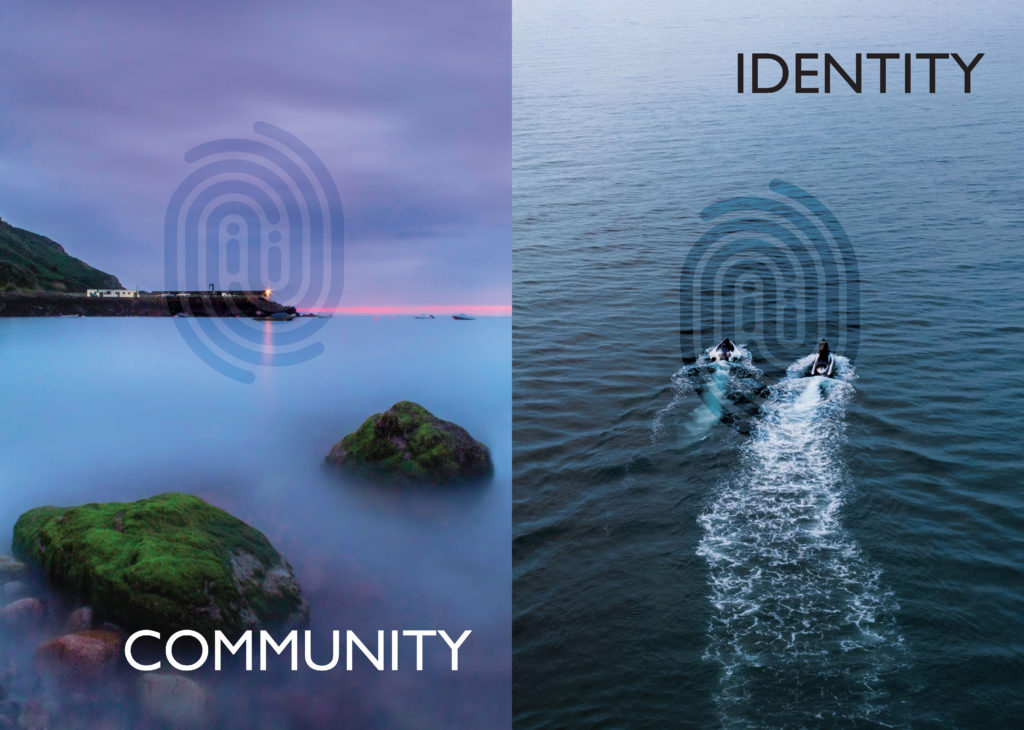
The newspaper was kindly sponsored by Deputy Carolyn Labey, Minister for International Development and Assistant Chief Minister who in her foreword shares her personal thoughts on what makes Jersey special to her in context of the Island Identity project led by her department. She says, ‘identity involves searching our soul, engaging with difficult issues, and asking not only who we are, but how others see us and what a vision for the future might look like. The perspective of students and young people in this debate is critical. Identity is a broad and far-reaching concept, one unique to all of us. This collection of images recognises both our differences and our commonalties. These times may be uncertain, but in my view the topic – ‘what Jersey means to you’ – is a fundamentally optimistic and forward-looking one.’
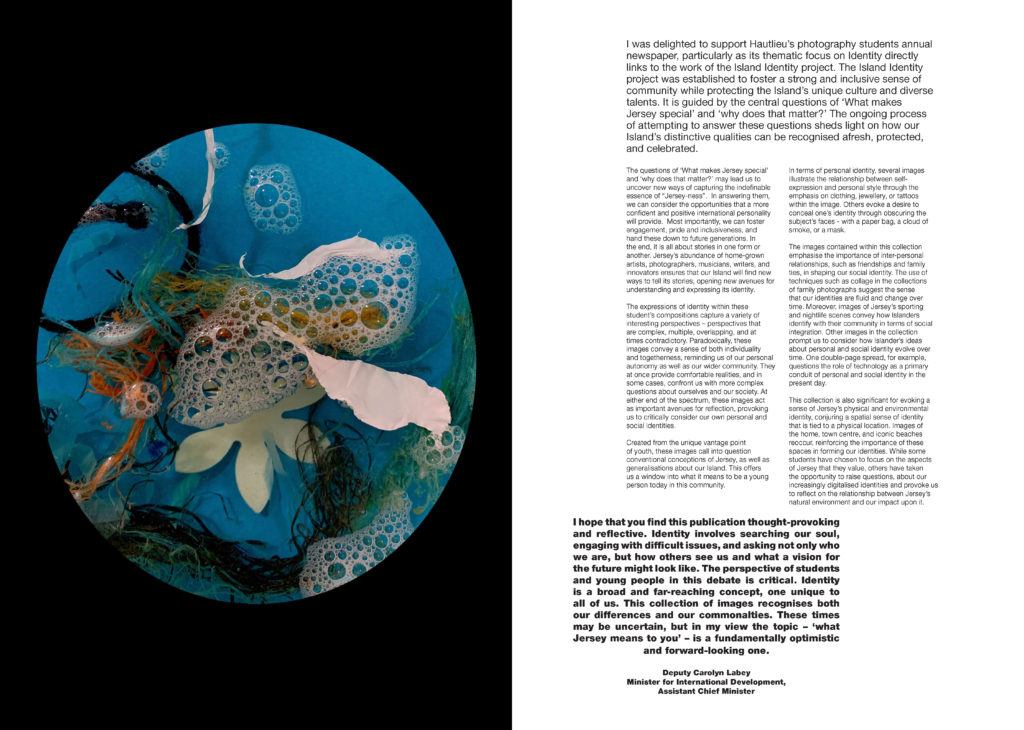
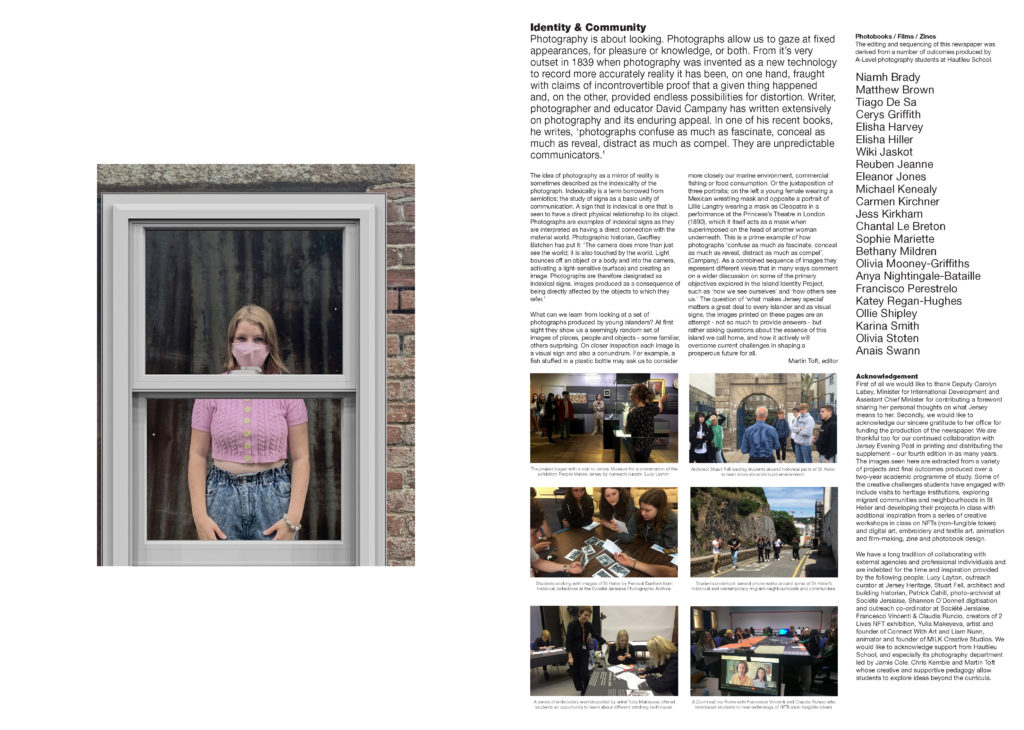
The Identity and Community newspaper is the fourth supplement produced in collaboration between Hautlieu School Photography Department and Jersey Evening Post. In 2018 the first issue was The Future of St Helier and last year the themes of Love & Rebellion explored experiences of isolation and lockdown during the coronavirus pandemic. Photographer and teacher Martin Toft, comments: ‘The question of ‘what makes Jersey special’ matters a great deal to every islander and as visual signs, the images printed on these pages are an attempt – not so much to provide answers – but rather asking questions about the essence of this island we call home, and how it actively will overcome current challenges in shaping a prosperous future for all.’
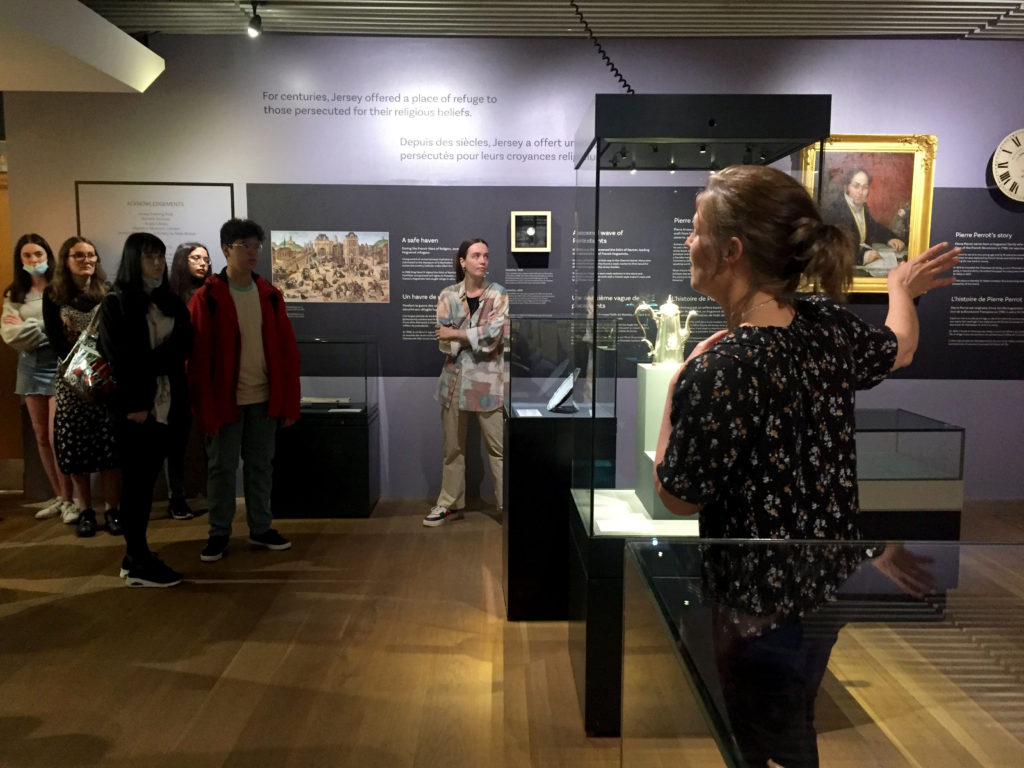
The image on the left of the first spread and the second double spread image are my selected images that have been included in the magazine.



























For my second photoshoot, I wanted to take portraits in an outdoor setting, similar to those of Lillie Langtry’s portraits taken in nature. To do this I picked an outside area with agriculture such as trees and flowers in order to capture the cascading sunlight onto the face. I also used the same costume from my first photoshoot to incorporate the vintage style of Lillie Langtry’s era. I used both a short and long lens to achieve a strong depth of field in some of my images, to recreate the same depth of field in the photos of Langtry.







Once adding my images into Lightroom, I rated them through the flag and colour system to narrow down the large group of images into a selection that I wanted to use and edit for my final images. The images highlighted in green are what I believe to be my most successful images and those which I want to further improve.

To edit my images, I began by adding a black and white filter to the images, and adjusted the exposure and contrast in a similar way to my first photoshoot to give the images a vintage aesthetic. By altering the exposure and contrast it enables the images to become lighter and softens the contrast between the highlights and the harsh shadows.

Then I added a yellow tone in colour grading to the images to create the idea of the images being faded and weathered. I also altered the temperature and tint of the image to make the images have a warmer yellow tone to them.

To add detail to the images, I added a grain affect and lowered the clarity and texture of the image to reinforce the image being ‘vintage’ and to recreate the grain and textures of an old film camera.

For my second photoshoot, I want to recreate images of Lillie Langtry with the natural and agricultural scenery.

To recreate images similar to this, I am using the same costume from my first photoshoot to give the images an antique aesthetic and to give the impression that the image was taken during the same era as Langtry in a fashion sense. I am also going to take the images outside rather than the studio to achieve the same cascading, natural lighting. I want the setting to feature agriculture such as trees and flowers to reiterate the ‘feminine’ ambience of the photo above.
I will try to achieve the strong depth of field that is displayed in the photographs of Langtry by using both a short and long lens.
To start creating my photo-book I first went through my photoshoots closely and decide which photos to use and also which photos could be edited and developed more to add details; as well as making sure my photos were of a high resolution.


Next I started on deciding the layout of the photos and where I should place them on each page as I felt that the way in which you place them has an impact on the viewer, which creates more of an understanding on what your trying to portray within the photo-book.

After I decided on the layouts of the photographs I decided that it may add more affect if I added a black background colour as this won’t take any attention away from the photographs it will add detail, whereas if I was to use a bright colour background with my photographs it may take attention away from them which is not what I’m trying to achieve. To show the significant differences within cultures, linking back to power and wealth I wanted to put my images from my first photoshoot of derelict buildings in the first half of my book along with the part of my essay that relates, and then with the second half of my photo-book I wanted to show the contrast within cultures by using images that I took in Dubai. Along with the contrast between my first set of images and my second set of images taken in Dubai, there is also images that show contrast within Dubai itself- with the notable differences between the old Dubai town, and the new well known Dubai Mall.

I then went ahead and combined the two books to create one as I felt that this will help the viewer clearly see the contrasts between the two photoshoots. I used 2 pages to separate the photoshoots and applied a black background cover to keep the overall theme of the book flowing.
After I finished my personal project, I printed some of the final outcomes from my previous work from y12 and wanted to display it .
I ended up putting all my photos on mounted backgrounds and used spray glue to make sure the images stay, I had to precisely cut them all out and trim them. as well as my final images I printed out my zine project which was about jersey’s history and different environments/ cultures. this was a booklet and I have some images down below showing my final outcomes;
I had some extra images for some of these outcomes therefore I experimented with my work and placed some of my smaller prints on top of the larger ones, this way it created a good illusion and gave the images a more abstract look.







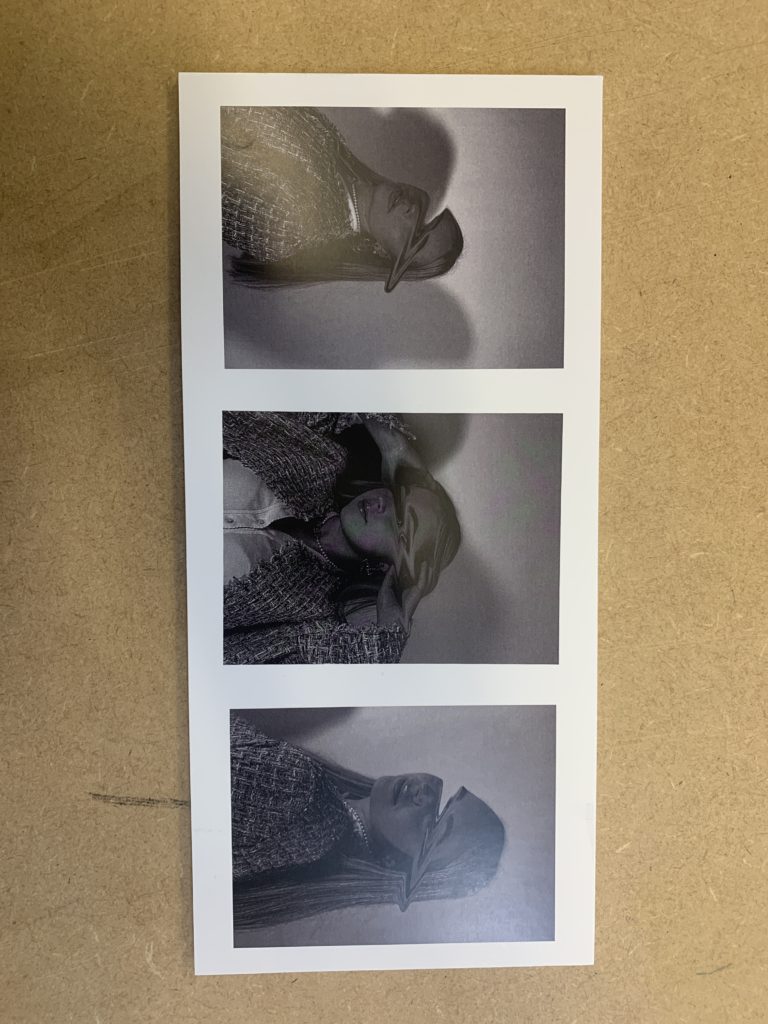




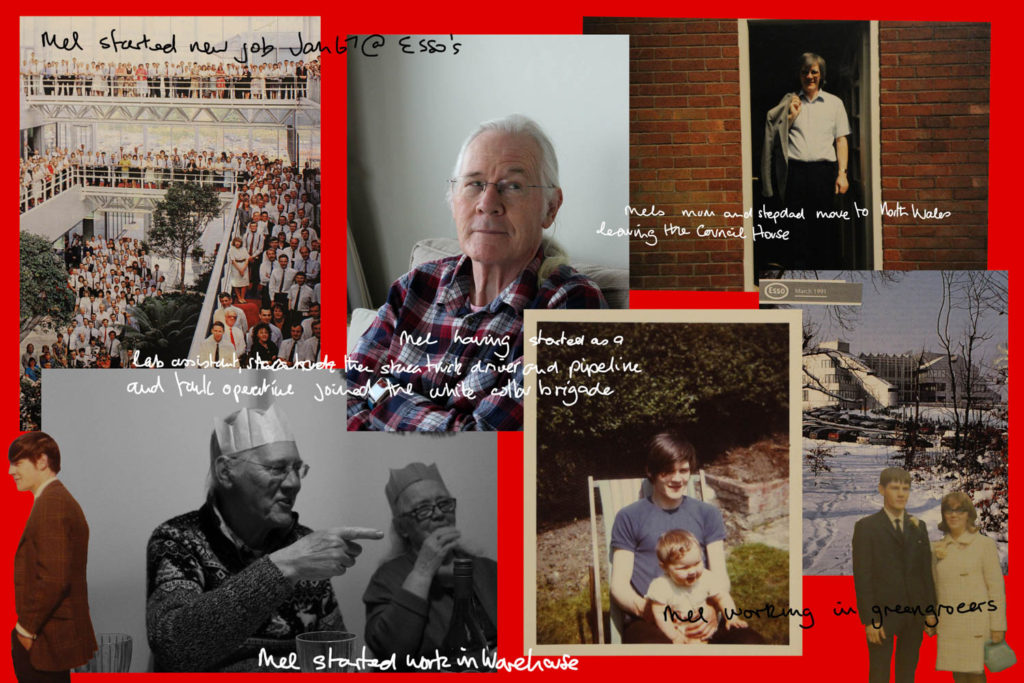


The images I have selected for my final prints contain a mixture of reworked archival and newly produced images. I believe that these pieces best capture the essence of my photobook and the narrative as a whole. This is to highlight the intent behind producing family photographs and memories, commenting on the fact that many of these images conceal or fail to express the reality of the people in the frame, and deconstructing the message behind them.






With my final images, I used artsteps.com to create a virtual gallery in which it is possible to have a 360 view of the gallery space. Here, I used more of my images from my photobook that are not from my final prints to create a more full looking gallery space.


Using Adobe Lightroom, I imported all of my final images from my personal study project for my photobook. Here I uploaded the images onto different pages and experimented with the layout of them, seeing which images worked best on opposite pages and complimented each other. I adjusted the size of the photographs on these pages, working out which images worked best as full bleeds and which looked better with a white border. From this I found that a full bleed portrait image next to a portrait with a white border looked best for my layout, with some double page spread full bleeds for landscape images. Although, on some pages I tried placing a landscape and portrait alongside each other and found it looked best when the landscape overlapped to pages displaying the portrait, or with two landscapes stacked on top of one another on one page, opposite to the portrait. In addition to this, I also experimented with the order of the pages and their ability to aid the narrative, as well as presented a balanced feel to the book. With this I found that the double page spread of my stitched family portrait, was a good anchor for the central page of my photos.

This is my final layout for my photobook named ‘Manufactured memories’ which includes over thirty images comprised of a montages, archival images and newly produced images, as well as my essay at the back of the book. I believe that this project went well, as I think I have produced a good amount of images that relate to the task of a personal study, as it is about my family, specifically my grandparents. In addition, I am happy with my layout and proud of the photobook I have produced.

For my front and back cover I used an image wrap of the photograph that will be central in my photobook. However for the cover I made the rest of my family, except from my grandparents, into silhouettes in Photoshop. I did this by using the quick select tool as well as the paintbrush tool to carefully fill in the areas I had stitched in white around. I believe this best represents the contents of my books as it displays the method of reworking images that will be presented throughout my book as well as highlighting who the book is focused on, this being my grandparents. The title manufactured memories was inspired from a quote by Joerg Colberg, featured in my essay, and describes the nature of most family photography and how my photobook aims to deconstruct this.

For these first pages, I decided to leave one page at the start of the book blank, allowing for my photographs to start on a double page and be equally distributed throughout the rest of the book. The first double page showcases two simple portraits of my grandparents, which were taken separately however work well together as it appears that they are looking at one another. The following page contains a candid image of my grandad taken at a family Christmas dinner, alongside a digitally edited archive image of him in his former workplace, with everyone’s but his face covered. On the third page I decided to place a close up of my grandparents hands and their rings next to a full bleed of an image of them both, in which I have stitched into and around them. The next pages display two landscape images overlapping, one being one of my own newly produced images, with county outlines stitched into them, and the other an archive image of my mum and my aunt taken during their moving of house. The 10th and 11th page are taken up by a full bleed, double page spread of a digital collage made featuring images and text relating to my grandad, on a bold red background.

The pages after this present a full bleed, digitally altered image of my great-grandparents, concealing the upper halves of their bodies, next to one of my own images of my mum and step-dad. Following this is a digitally altered archive image of my grandad at his former workplace, surrounded by multiple emails regarding his retirement. The next two pages feature three images, two being candids from Christmas dinner, and the other a digitally edited archive image of my grandparents, with hexagons and the Manchester worker bee surrounding them. The central page of my photographs contains a full bleed, double page spread of a family portrait I have stitched into. After this is another three image page with two landscapes on one side, one being a stitched into family portrait and another a Christmas dinner candid, alongside a newly produced portrait of my grandparents, also with hexagons and the Manchester worker bee surrounding them, however this time stitched in. Following these pages are a digitally altered image of my grandma with text in her own handwriting surrounding her, with her old college ID and certificate for her nursery course next to it.

Next is a full bleed, archival portrait of my grandparents, mum and aunt, with an outline of my grandparents stitched in, alongside a Christmas dinner candid. Following this is another full bleed, double spread collage, this time featuring images, text and documents about my grandma. After this is a digitally edited, archival image of my families old house they moved into after my grandad’s new job, next to an archival image of my mum and aunt standing in the doorway of the house they were moving out of. The next pages display another close up of my grandparents hands, this time featuring another ring my grandad gifted to her, with a full bleed, stitched into portrait I have taken next to it. Following this is a landscape image of my aunt and her son (my cousin), next to an archive image of my grandma, mum, aunt and my sister as a child. The final photographic pages in my book showcase a full bleed, digitally altered, archival image of my grandma who is surrounded by a repeated sentence in her own handwriting, followed by a new portrait taken of my grandma, aunt and mum.

After all of my images, I have included my essay regarding this project, with my influences, analysis’ and intentions. This piece of text is also supported by images from other artists and quotes from other literary sources, which are referenced within my bibliography. I added this in by copying and pasting my essay in paragraphs, fitting the images it references around the text.
Once completing the layout and design for my photobook I then uploaded it to the website blurb which will allow me to order the photobook and print it for me.